David's Astronomy Pages
|
Notes (S170) |
Notes (Main) |
Home Page |
Notes (S197) |
|
Base Line Observations of XO-2, Parent Star to Exosolar Planet Base Line Observations of HAT-P-2 , Parent Star to Exosolar Planet Arcturus - Diffraction Spike Patterns (CBRVI filters) >
Series of baseline images of XO-2 (host star to
exosolar planet XO-2b) were acquired through C and BVRI filters.
A suitable comparison star (C) and check star (K) are conveniently positioned,
and are of relatively similar magnitudes to XO-2.
R Band was selected for an initial short baseline image set, as it shows higher
S/N and will be less effected by atmospheric extinction effects, related to the
difference in colour indices between XO-2 (Est. B-V = x.xx) and the
Comparison Star (B-V=0.34 / Bt-Vt=0.39)
R Band images were acquired with 45sec and 30sec exposure at airmass values of 1.56 to 1.60. These showed XO-2 to have a calculated R Band magnitude of 10.75+/- 0.03 (this ignores the second data point with a clearly anomalous value for XO-2)
Analysis of S/N values show significant fluctuations and indicate that the baseline images were most probably being affected by interfering cloud. Highest S/N values achieved were around 80 for a 30 sec exposure but dropped to 18 for the most effected image. Assuming constant atmosphere a S/N ratio of 80 would roughly correspond to a potential precision of 0.013 (from 1/SNR).
Plotting the difference between calculated XO-2 magnitude and average XO-2 magnitude shows a range from -0.028 to +0.027 (or a SD of 0.021). This would suggest that only ideal sky conditions would lead to a detection of the exosolar planet transit (the transit causes only 0.015 reduction in flux).
XO-2 [ http://arxiv.org/PS_cache/arxiv/pdf/0705/0705.0003v1.pdf]
| XO-2 / GSC 3413:5, Reference Stars |
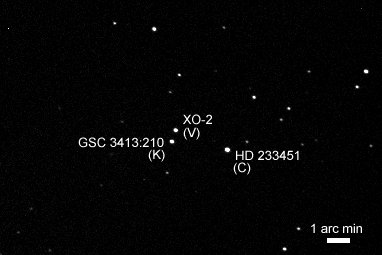 |
| Annotated CCD Image 30s, 2x2 binning, R Filter 2007-05-07 23:07 hUT (#196040) |
| Analysis of XO-2 Base Line Images (R Band) |
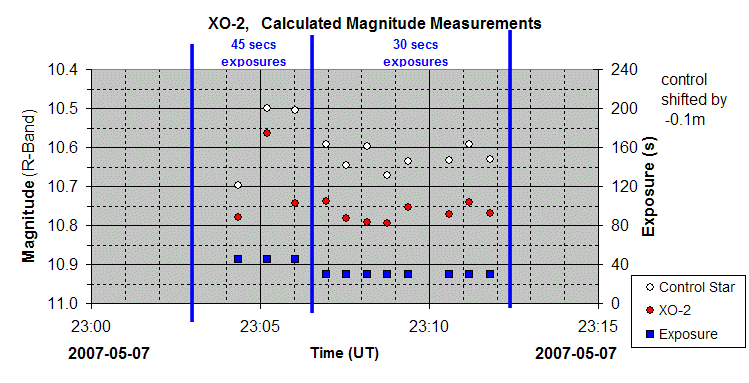 |
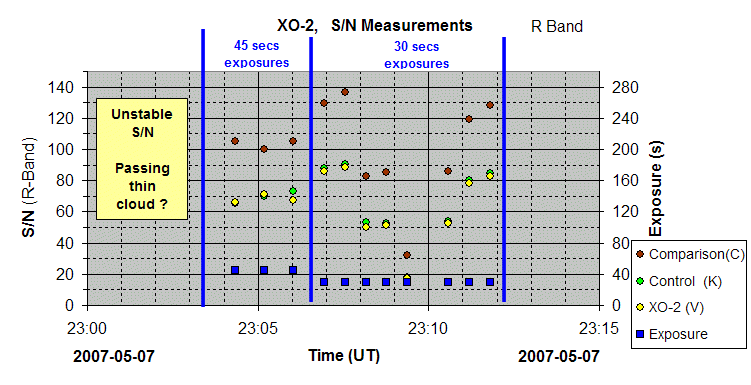 |
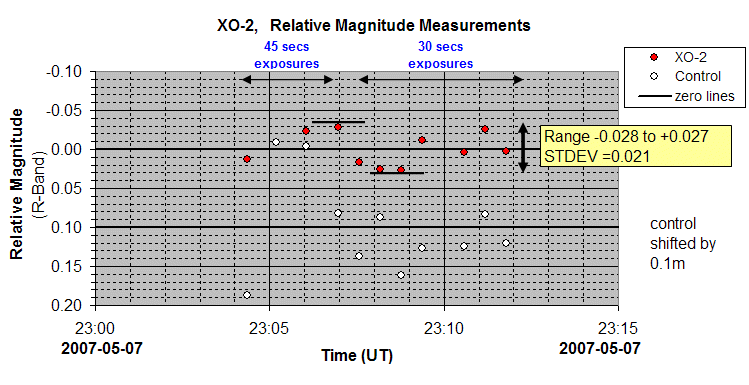
|
|
XO-2 / GSC 3413:5 (Lynx) |
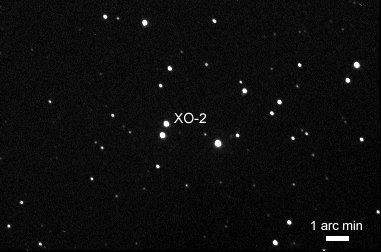 |
|
Annotated CCD Image 3 x 60s (average combine), 2x2 binning, C Filter 2007-05-07 22:56 hUT (#196028-30) |
Back to Top
Series of baseline images of HAT-P-2 (host star
to exosolar planet HAT-P-2b) were acquired through C and BVRI filters.
A suitable comparison star (C) and check star (K) are conveniently positioned,
and are of relatively similar magnitudes to HAT-P-2. All three stars are
relatively bright which will allow relative short exposures to achieve high
S/N..
R Band was selected for an initial short baseline image set, as it shows higher
S/N and will be less effected by atmospheric extinction effects, related to the
difference in colour indices between HAT-P-2 (Bt-Vt= 0.49 / B-V = 0.42)
and the Comparison Star (Bt-Vt=1.42 / B-V=1.20).
R Band images were acquired with 45s, 20s and 15s exposure at airmass values of 1.10. Using the 20s & 15s images (which had stable S/N values), the calculated R Band magnitude of HAT-P-2 is 8.36 +/- 0.01. This compares with an expected R Band magnitude of 8.47 (based on Arne Equations using Bt, Vt).
Analysis of S/N values show significant fluctuations for the first few images (45s exposure) indicating that they were most probably being affected by interfering cloud. Subsequent images (20s &15s exposure) show very stable S/N values indicating clear sky conditions. For 20s exposures the average S/N value achieved for HAT-P-2 was 250 (potential precision of 0.004 mag, using 1/SNR), whilst for 15s exposures the average S/N achieved was 217 (potential precision of 0.005 mag). Comparison star has even higher S/N which provides strong encouragement that a successful detection of a HAT-P-2b transit could be achieved at a later date.
Plotting the difference between calculated HAT-P-2 magnitude of individual images and average HAT-P-2 magnitude shows a range from -0.012 to +0.014 (or a SD of 0.007). Again this suggests that with clear sky conditions a detection of the exosolar planet transit could be readily achieved. (the transit causes only 0.015 reduction in flux).
| HAT-P-2, Reference Stars |
 |
| Annotated CCD Image 20s, 2x2 binning, R Filter 2007-05-07 23:31 hUT (#196065) |
| Analysis of HAT-P-2 Base Line Images (R Band) |
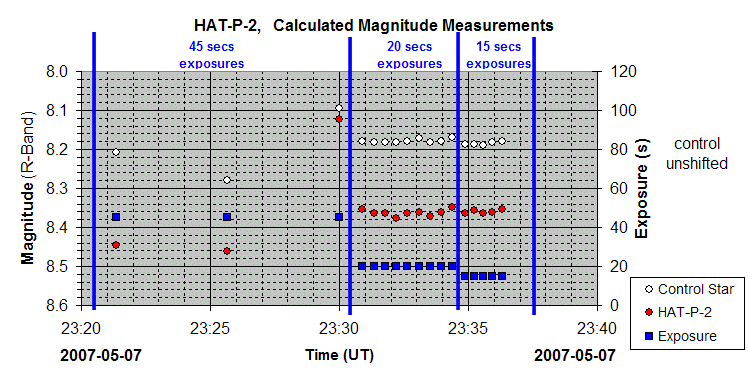 |
 |
 |
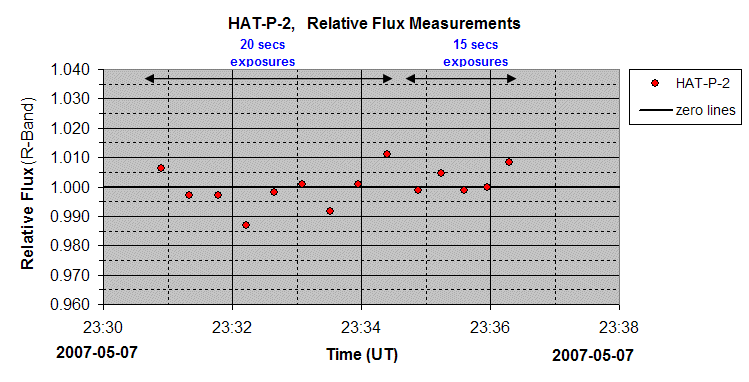 |
|
HAT-P-2 (Hercules) |
 |
|
Annotated CCD Image 3 x 60s (average combine), 2x2 binning, C Filter 2007-05-07 23:23 hUT (#196053-61) |
Back to Top
During initial alignment of the telescope, a slightly out of focus image of Arcturus was noted to have particular noticeable diffraction spikes.
The opportunity was taken to explore the diffractions spike patterns through
BVRI filters .
| Arcturus Defocussed with diffraction spike patterns |
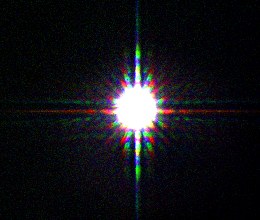 |
| Combined Approximate Colour Image Blue : 10s (B Filter), Green : 3s (V Filter), Red : 3s (R Filter) 2007-05-07 |
| Montage of Images of Arcturus |
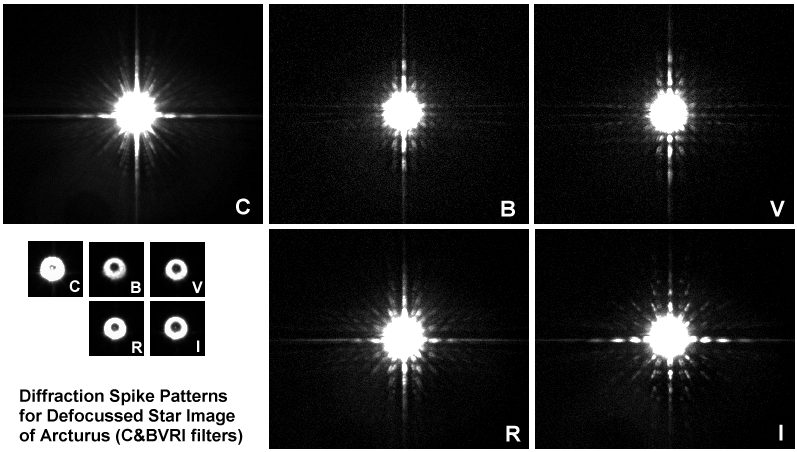 |
Back to Top
| This Web Page: | Notes - Session 196 (2007-05-07) |
| Last Updated : | 2015-05-16 |
| Site Owner : | David Richards |
| Home Page : | David's Astronomy Web Site |